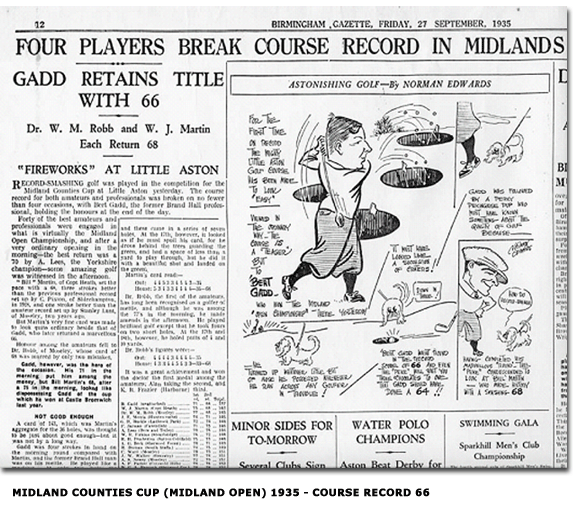|
| |
|
(Max Faulkner was known to do that in later years). On
one occasion Laffoon broke the offending implement by smashing it
against his foot, but also broke his toe in the process. It was Laffoon’s only match in the Ryder cup, but Dutra went on to win his
single against Alf Padgham by 4&2. The Chairman of the USPGA
Tournament committee, 6'5" Dutra was a heavyweight in both the
physical and the golfing sense. He had won the US Open the previous
year and the US PGA in 1932. Our Open Champion, Alf Perry and
partner Jack Busson lost in the top match to the dream pairing of
American captain Walter Hagen and Gene Sarazen by 7 and 6. It was
the first year that Hagen did not play in the singles, but he was
not needed. The only British winner was Percy Alliss, who defeated
the big hitting Craig Wood 1 up. In the week of the Ryder Cup I defended the Midland Open Championship at one of the finest inland courses in Britain-Little Aston, where Charlie Ward was to be playing pro for much of his career. Harry Vardon was the original designer, with some of the later revisions by Harry Colt, the architect of Brancepeth Castle and the result is a classic. On my way to a successful defence of the title I broke the pro course record with a 66, recorded in the form of a cartoon in the Birmingham Gazette, a copy of which hangs in the Little Aston clubhouse. It depicted me being followed around the course by a Pekingese pup belonging to a Lady member. I was to appear in some other amusing cartoons, as you will hear later.  The Irish Open was at another great course, the beautiful Royal County Down where ‘the Mountains of Mourne sweep down to the sea’. The course was originally designed by Old Tom Morris and was improved by Harry Colt in 1926. It is considered by many to be one of the world’s most difficult golf courses. I seemed to be at home on Colt courses and I equalled the course record in the final round moving me up from 45th to 10th place. My 67 matched the score set by Archie Compston and, believe it or not, I still hold a course record that I equalled getting on for seventy years ago. When the Golfers Handbook last published course records in 1999 it was still recorded as the professional record because, although the course was extended after the war, no professional tournaments had been played on it and at the time of writing none have been played since. (The Seniors British Open was played over a shorter course). NEXT |
